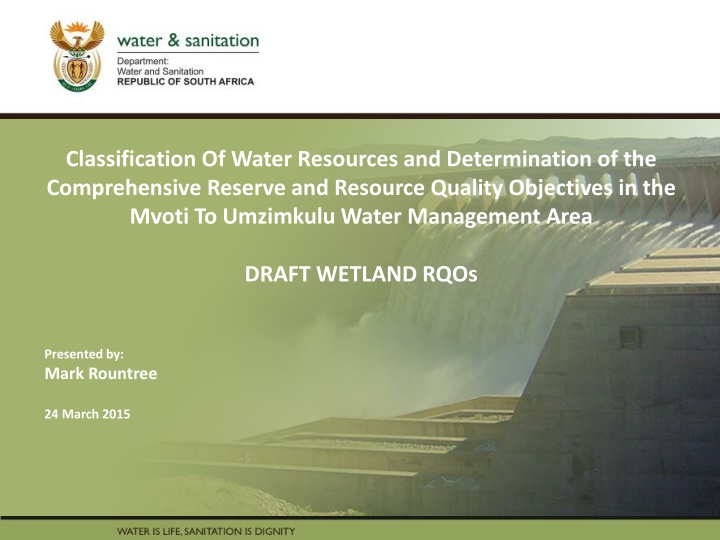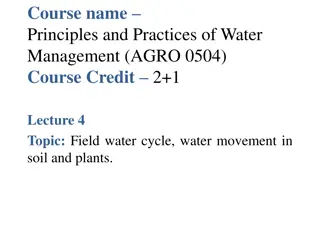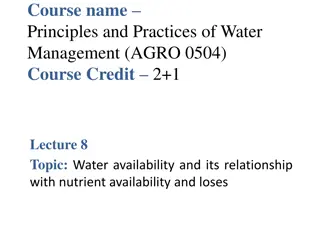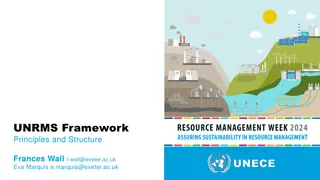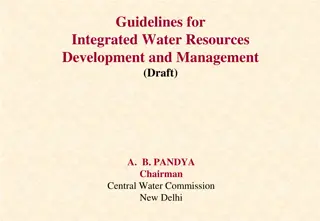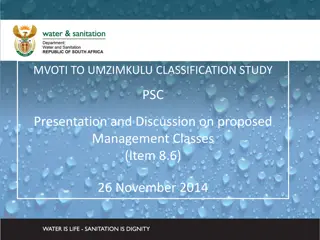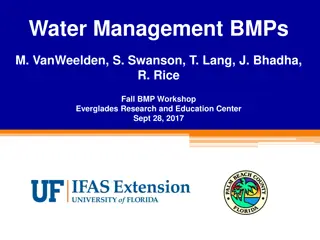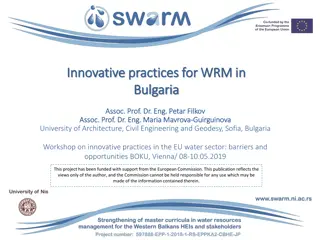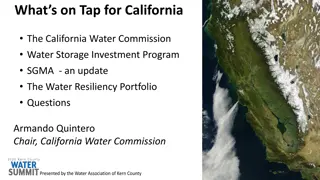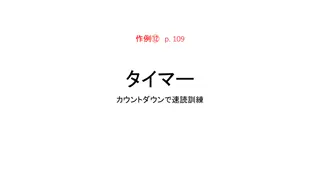Comprehensive Water Resource Classification and Management in Mvoti to Umzimkulu
This presentation discusses the assessment and management of wetlands in the Mvoti Water Management Area through the establishment of Resource Quality Objectives. It highlights the importance of wetlands, key strategies for wetland management, and the prioritization of wetland conservation efforts based on different levels of Resource Quality Objectives. The presentation emphasizes the importance of maintaining healthy ecosystems and outlines specific actions towards achieving conservation objectives for wetlands in the region.
Download Presentation

Please find below an Image/Link to download the presentation.
The content on the website is provided AS IS for your information and personal use only. It may not be sold, licensed, or shared on other websites without obtaining consent from the author.If you encounter any issues during the download, it is possible that the publisher has removed the file from their server.
You are allowed to download the files provided on this website for personal or commercial use, subject to the condition that they are used lawfully. All files are the property of their respective owners.
The content on the website is provided AS IS for your information and personal use only. It may not be sold, licensed, or shared on other websites without obtaining consent from the author.
E N D
Presentation Transcript
Classification Of Water Resources and Determination of the PRESENTATION TITLE Comprehensive Reserve and Resource Quality Objectives in the Mvoti To Umzimkulu Water Management Area Presented by: Name Surname Directorate DRAFT WETLAND RQOs Date Presented by: Mark Rountree 24 March 2015
BACKGROUND Wetlands in the Mvoti WMA There are many thousands of wetlands in the Mvoti WMA (Nel et al. 2011), including two Ramsar wetlands (Ntsikeni wetland & Mngeni sponge). Activities in and around all wetlands are subject to authorisations under the National Water Act. The DWS evaluates proposed developments through the WULA system. RQOs are a set of narrative and/or numerical management objectives defined for water resources. These set the objectives for the desired condition of the resource and can be used to guide the evaluation of WULAs. Verified baseline information is required to set a RQO.
BACKGROUND DWS and Wetlands The DWS s National Water Resource Strategy (DWA, 2013) provides for two key aspects related to the management of wetlands, namely to 1. address proactively, as well as remedially, the loss and degradation of wetlands and 2. maintain healthy, functional ecosystems. In addition to the NWRS, the DWS s National Wetland Position Paper (in prep) has proposed an objective that there be no net loss of wetland ecosystem functions in South Africa. The draft RQOs for the wetlands of the Mvoti WMA attempt to adhere to the objectives for wetlands proposed by these two national strategy documents.
APPROACH Levels of RQOs Three levels of RQO s have been identified for wetlands: - Level 3 RQOs for priority wetlands (individual high priority wetlands) - Level 2 RQOs for high priority catchments (average wetland EIS is moderate, high or very high) - Level 1 RQOs for all other wetlands, and potential FEPAs
APPROACH Level 1 RQOs for priority individual wetlands In 2012 each sub-quaternary catchment was assessed to identify large (level 1) FEPA wetlands which were directly dependent on river flows. These were prioritised in the identification of key hotspots for the selection of river EWR sites Hotspots used in the IUAs and analysis of scenarios for the WMA None of the flow scenarios impacts upon wetlands. However, many impacts upon wetlands are non-flow related
APPROACH Level 1 RQOs for priority individual wetlands Regardless of river flow dependence, other priority wetlands (Ramsar sites, Important Birding Areas and priority Ezemvelo KZN wildlife wetland monitoring sites) were also identified. Of these, 4 high priority sites (including the two RAMSAR sites) had existing monitoring (EcoStatus) data which allowed for the generation of specific RQOs. The four high priority wetlands in the Mvoti WMA were: Ntsikeni wetland (a Ramsar wetland) Mgeni sponge (a Ramsar wetland) The Mvoti vlei (priority KZN Ezemvelo monitoring site), and The Swamp (priority KZN Ezemvelo wetland monitoring site).
APPROACH Level 2 RQOs for priority catchments (1) There are many thousands of wetlands in the Mvoti and it is unrealistic to try to define or monitor specific RQOs for each individual wetland. Moreover, there was no widespread EcoStatus (baseline condition) information of the wetlands. In 2012 a desktop assessment to estimate the EIS of wetlands per quaternary catchment was undertaken to provide some indication of priority wetland catchments within the WMA. These desktop data identified priority wetland catchments those with moderate, high or very high EIS.
APPROACH Level 2 RQOs for priority catchments (2) These data provide an indication of catchments with important (moderate or higher EIS) wetlands. Ramsar wetland Priority Ezemvelo KZN Wildlife wetland
APPROACH Level 2 RQOs for priority catchments (3) For the priority catchments (moderate, high or very high EIS), an average PES category was determined A variety of within-wetland and catchment landuse activities and condition scored to estimate PES Small sample size of field data (n=8), but good correlation between desktop assessed and field verified scores (R2 = 0.866).
APPROACH Level 2 RQOs for priority catchments (4) Baseline PES for priority catchments (moderate, high or very high EIS)
APPROACH Level 3 RQOs for general wetlands and other FEPAs For all wetlands within the WMA (including non-priority catchments), ecosystem services of wetlands must be maintained (objective of the DWS s Wetland Position Paper). Across the WMA, FEPA wetlands (desktop estimates of potential priortity wetlands) are present. Level 1 RQOs relating to FEPA wetlands have been set in the event that data (verification) on specific wetlands becomes available in the future. These RQOs aim to maintain the TARGET (or achieve, if Target is higher than PES) the EC of the wetland for water quantity, quality, habitat and key biota components.
LEVEL 3 RQOs Priority wetland: Mngeni Sponge (RAMSAR) Mgeni sponge (Ramsar wetland) RQO Indicator IUA and SQ Component Sub-component Numerical Wetland hydrology score. Detailed assessment of wetland hydrology using a PES tool at 3 - 5 years intervals. PES is a C and must be maintained or improved. Water availability Hydrology Wetland geomorphology score. Geomorphology module of a wetland PES tool at 3 - 5 year intervals. PES is an A and must be maintained or improved. Geomorphology MRU uMnA (U20A-04253 ) Wetland vegetation score: assessment of vegetation using a wetland PES tool at 3 - 5 year intervals. PES is a C and must be maintained or improved. Habitat General vegetation Wetland PES assessment tool at 3 - 5 year intervals. PES is a C and must be maintained or improved. PES overall Presence of at least 5 breeding pairs of wattled crane and breeding success. The number of breeding pairs of wattled crane. Biota Wattled cranes
LEVEL 3 RQOs Priority wetland: Ntsikeni wetland (RAMSAR) Ntsikeni wetland (Ramsar wetland) RQO IUA and SQ Indicator Component Sub-component Numerical Wetland hydrology score. Detailed assessment of wetland hydrology using a PES tool at 3 - 5 years intervals. PES is an A and must be maintained or improved. Water availability Hydrology Wetland geomorphology score. Geomorphology module of a wetland PES tool at 3 - 5 year intervals. PES is an A and must be maintained or improved. Geomorphology Ru Mz8 (T51H-04846) Wetland vegetation score: assessment of vegetation using a wetland PES tool at 3 - 5 year intervals. Habitat PES is a B and must be maintained or improved. General vegetation PES is an A and must be maintained or improved. Wetland PES assessment tool at 3 - 5 year intervals. PES overall Presence of at least 3 breeding pairs of wattled crane and breeding success. The number of breeding pairs of wattled crane (baseline of 2014). Wattled cranes Biota Annual presence of European Bittern migrants (sighted or indicated from call). Annual presence of European Bitterns. European Bittern
LEVEL 3 RQOs Priority wetlands: The Swamp The Swamp (priority KZN Ezemvelo wetland monitoring site) RQO IUA and SQ Indicator Component Sub-component Numerical PES is a D and must be maintained or improved. Wetland hydrology score. Detailed assessment of wetland hydrology using a PES tool at 3 - 5 years intervals. Water availability Hydrology Wetland geomorphology score. Geomorphology module of a wetland PES tool at 3-5 year intervals. PES is a C and must be maintained or improved. RU Mz4 (T51E-04478) Geomorphology Wetland vegetation score: assessment of vegetation using a wetland PES tool at 3 -5 year intervals. Habitat PES is a C and must be maintained or improved. General vegetation PES is a C and must be maintained or improved. Wetland PES assessment tool at 3 - 5 year intervals. PES overall Current areas are not known, but should not reduce more than 20% below baseline. Biota (key vegetation species) Cyperus marginatus vegetation Area of vegetation type at 3 - 5 year intervals.
LEVEL 3 RQOs Priority wetlands: Mvoti Vlei The Mvoti vlei (priority KZN Ezemvelo monitoring site) RQO IUA and SQ Indicator Component Sub-component Numerical PES is an E and must be maintained or improved. Wetland hydrology score. Detailed assessment of wetland hydrology using a PES tool at 3 - 5 years intervals. Water availability Hydrology MRU Mvoti A(U40A- 03869) Wetland geomorphology score. Geomorphology module of a wetland PES tool at 3-5 year intervals. PES is an A and must be maintained. Geomorphology Wetland vegetation score: assessment of vegetation using a wetland PES tool at 3 -5 year intervals. Habitat PES is a D and must be maintained or improved. General vegetation PES is a D and must be maintained or improved. Wetland PES assessment tool at 3 - 5 year intervals. PES overall
LEVEL 2 RQOs Priority catchments (moderate, high or very high EIS) The RQOs identified for wetlands in priority catchments aim to maintain the average condition of the wetlands (Target is PES).
LEVEL 2 RQOs Priority catchments (moderate, high or very high EIS) RQO Descriptive Applicable wetlands IUA Component Indicator Reference All wetlands within quaternary catchments which have moderate, high or very high EIS The TARGET EC of the wetlands in a catchment must be maintained. The average PES of the quaternary catchment All Habitat NWRS
LEVEL 1 RQOs All wetlands and wetland FEPAs RQO Descriptive Applicable wetlands IUA Component Indicator Reference The ecosystem services of wetlands in a catchment must be maintained. Ecosystem Services Hectare equivalents (PES x area) can be taken as a coarse indicator of ecosystem services. The National Wetland Position Paper (in prep), All wetlands within the WMA All For FEPAs: - Flow and inundation regime must maintain wetland FEPAs in target EC - Water quality must be sufficient to maintain wetland FEPAs in target EC - Species diversity and health of boita should be maintained (includes the feeding, breeding and movement of fauna and flora) - Specific Baseline and Target EC of FEPAs are not verified - Assessment of the current condition and presence/count of significant biota is recommended. - Numerical RQO criteria should equate to the current condition and/or presence (or counts) of key species
RQOs FOR WETLANDS RQOs for priority catchments (FEPAs within priority catchments) RQO IUAApplicable wetlands Component Indicator Reference Descriptive Numerical Validated wetland FEPAs in a good condition (A B EC) Water quality is sufficient to maintain the current PES. FEPA wetlands have not been verified, and EWRs and PES for these wetlands have yet to be determined. National Freshwater Ecosystem Priority Areas (Driver et al., 2011). Water quality must maintain wetland FEPAs in good condition. Water Quality All Validated wetland FEPAs in a modified condition (C - F EC) Water quality is sufficient to achieve the REC.
RQOs FOR WETLANDS RQOs for priority catchments (FEPAs within priority catchments) RQO IUAApplicable wetlands Component Indicator Reference Descriptive Species diversity and health of biotic communities supported by wetland FEPAs should be maintained. This includes the feeding, breeding and movement of fauna and flora. Numerical PES of all the wetlands is unknown. An assessment of the current condition and presence/count of significant biota is required to develop numerical targets. Validated wetland FEPAs in a good condition (A B EC) Habitat condition is sufficient to maintain the current PES. National Freshwater Ecosystem Priority Areas (Driver et al., 2011). Habitat and biota All Validated wetland FEPAs in a modified condition (C - F EC) The numerical criteria should equate to the current condition of the wetlands and/or presence (or counts) of key species within them. Habitat condition is sufficient to achieve the REC.
RQOs FOR WETLANDS Summary Available data has been used to set RQOs for high priority individual wetlands in the Mvoti WMA For the remaining thousands of wetlands where baseline data are not available per wetland, quaternary-scale RQOs have been set for priority catchments (where wetland EIS is moderate, high or very high). A variety of recommendations, organised according to impact types, are provided which could be used as guidelines or WULA conditions to enable the RQOs to be achieved.
